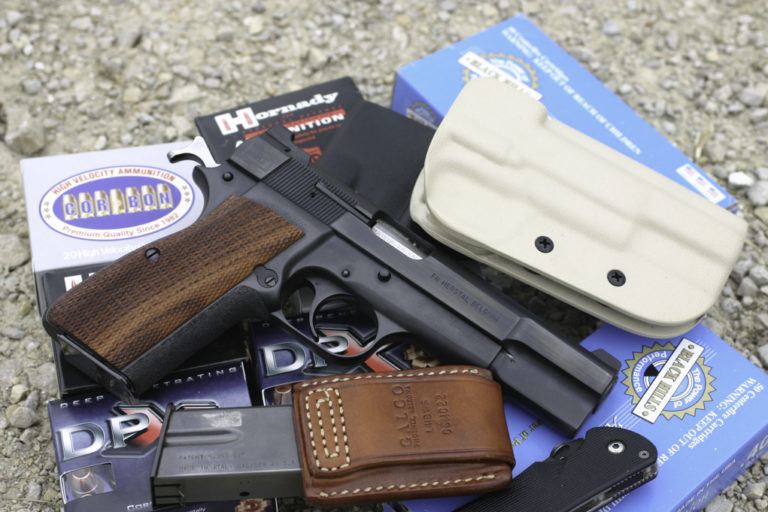
It May Be Surpassed, But There’s Nothing Like a Genuine Browning Hi Power!
Basics of the Browning Hi Power:
- Designed from 1914 to 1935.
- Served from 1935 nearly to present day.
- One of the most widely used military pistols in history.
- Chambered in 9x19mm, 7.65x21mm and .40 S&W.
- 10- to 17-round capacity, depending on caliber.
- Lock-breach semi-auto.
- Browning discontinued production in 2017.
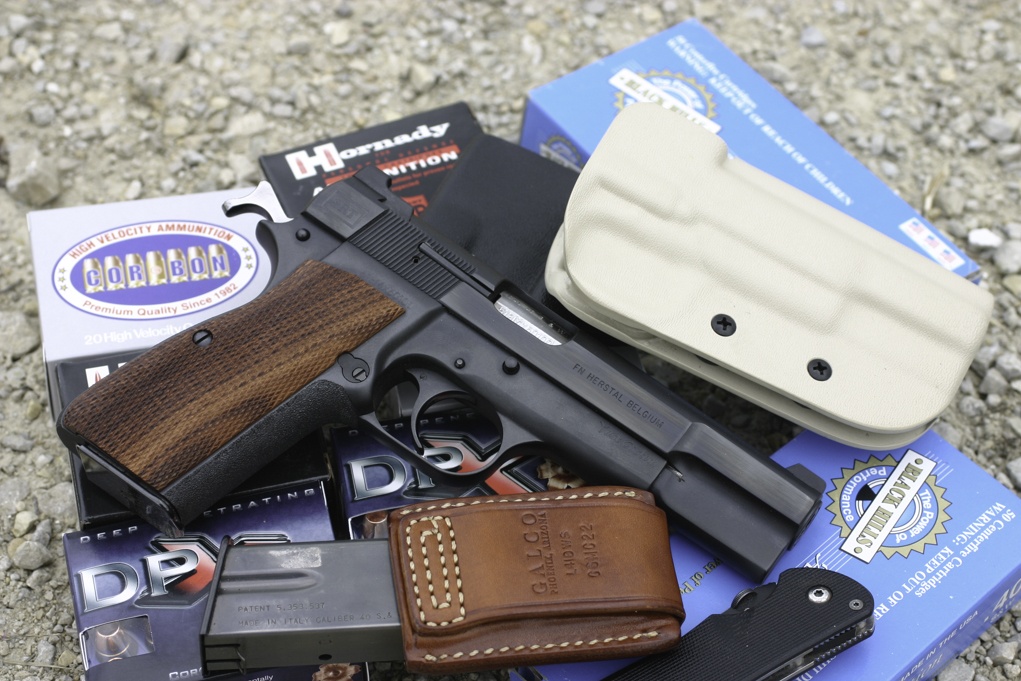
In the immortal words of the great Dr. Who, “There comes an end to everything. The last door you walk through. The last room you enter.” To which I add: The last Browning Hi Power to be made.
The question is, which one was last? What was its serial number? Where is it located today? I don’t know, because, well, Fabrique Nationale just doesn’t talk much about what goes on inside the walls of their plant. What happens in Liege, stays in Liege, I guess.
But you can hardly buy a brand new Hi Power any longer, and those who import them, or try, can’t get them. How did this happen? To figure that out, we must go back to the beginning.
After the Great War, aka World War I, the smart military establishments planned and stockpiled for subsequent conflicts. However, governments and people were tired of paying for war and, as a result, budgets were tight. It took a while to get around to purchasing new handguns.
The FN-Browning Connection
When the French Army came looking, FN turned to the late, great John Browning as they had for so many previous firearms. He worked up a prototype and it was a doozy. Browning’s creation was chambered in 9mm, held 17 rounds, and the slide portion of the firing mechanism could be removed as a complete assembly. It was, in that regard, just like the Savage pistols. Potentially, you could change the same pistol from a duty trigger to a target trigger and back again in a few seconds. The Browning Museum, in Ogden, Utah has the prototype on display.

Alas, before he could complete it, John Browning passed away. Work on the pistol then went to Dieudonné Saive, the FN designer who would later design the FN-49, the forerunner of the FAL. Saive ironed out the details of a double-column magazine, which fed to a single feed point, for use in pistols.
By the early 1930s, the French Army was ready to begin trials but, (and apologies here) being French, they just couldn’t decide. After a few fruitless attempts at trying to satisfy the French, FN made the pistol its own as the P-35. (In the end, the French selected a single-stack .32-caliber pistol, which used a cartridge remarkably like the .30 Pedersen. It was designed and manufactured in France.)
The P-35 was hardly through its initial production run when the whole world came apart. In 1940 the Germans overran Belgium, and once the Nazis had cleared the dust and rubble from the machinery in Liege they had the plant up and running again for the Reich. Despite the quick advance, a few of the essential staff and designers managed to get out of Dodge, as it were. The Hi Power blueprints were spirited off to Canada, where John Inglis & Co. set up production for use by the Allies. Thus began the decades-long irony of both sides in a conflict using a pistol of the same design.
The Germans produced hundreds of thousands of the P-35, noted in inventory and marked as the “Pistole 640(b).” Pretty much everywhere they went, when the Germans took over they kept the production lines of whatever was being made going in their name. Those 640(b) pistols were, for the most part, shipped off to the Eastern Front where they were used, captured, picked up, and later stored in Soviet warehouses.
The Canadian model, the Inglis P-35, went to the armed forces in Commonwealth service, as American troops received 1911A1s and various Colt and Smith & Wesson revolvers, for use in the war.
Sweeney Discovers the Browning Hi Power
My first introduction to the Hi Power came when I was working at The Gun Room, a gun store I called employer from 1978 to 1982 or so.
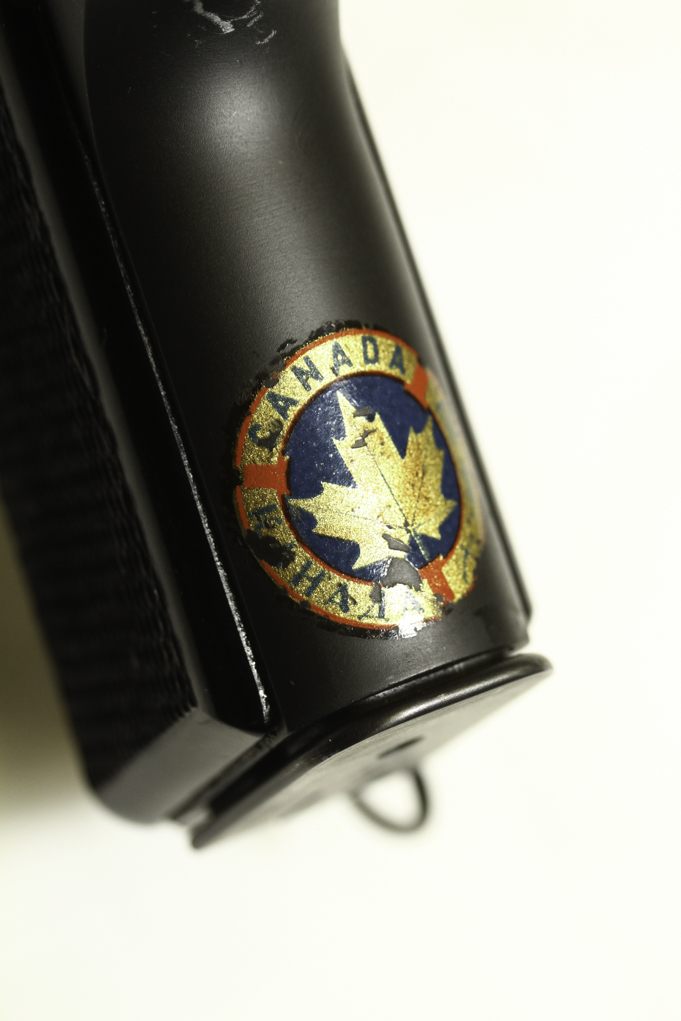
One time, we had a weekend barbeque at the boss’s house out in the country. This included shooting all the odd, rare, different or just loud firearms that we had in the shop or in our personal safes. When the rain began we retired into the walk-out basement and fired out of the sliding door, across the patio. (A brief aside: when firing a handgun chambered in 7.63 Tokarev from inside of a room, it is best to be wearing both earplugs and over-the-ears muffs.) I was handed a Browning Hi Power to shoot.
To give you the full flavor of the event, the pistol was a commercial-polished blue, pre-war, tangent-sight model, but with Waffenampt proofs. It was a pre-war commercial gun, cut for a shoulder stock as many back then were, that had been appropriated by the Germans while still in the FN vaults, stamped, and issued for use in the war effort. It was most likely shipped to a Waffen SS or Fallschirmjaeger unit.
Bone Up On Browning:
- Browning Firearms: The 9 Best Gun Designs Ever (2020)
- Browning Buckmark Review: Timeless .22 Rimfire Pistol
- Browning Automatic Rifle: The Gun That Changed the Infantry
- Browning A5 Shotgun: The First Autoloader
- Browning Citori: The World’s Most Popular Over/Under Shotgun
- Is There A Better Browning BLR Than The Lightweight ’81 Takedown?
- Browning Shotguns: The Top 10 Greatest Ever!
I slapped in a 20-round magazine and began shooting. “Hmm, the recoil seems a bit sharp compared to the other handguns. It does hit to the sights. The grips are a bit blocky.”
Just as I was finishing, my internal monologue was interrupted by the owner. “What are you doing?” Looking down, my reply was, “Bleeding, I think.” The sharp recoil was caused by the hammer biting the web of my hand, and the result was me bleeding all over the Browning. Sorry about that, Roger.
Two valuable lessons learned that day: The P-35 bites if you use the then-new IPSC hand grip. And blood, when properly cleaned from blued steel and wooden grips, does not leave any lasting marks or stains.
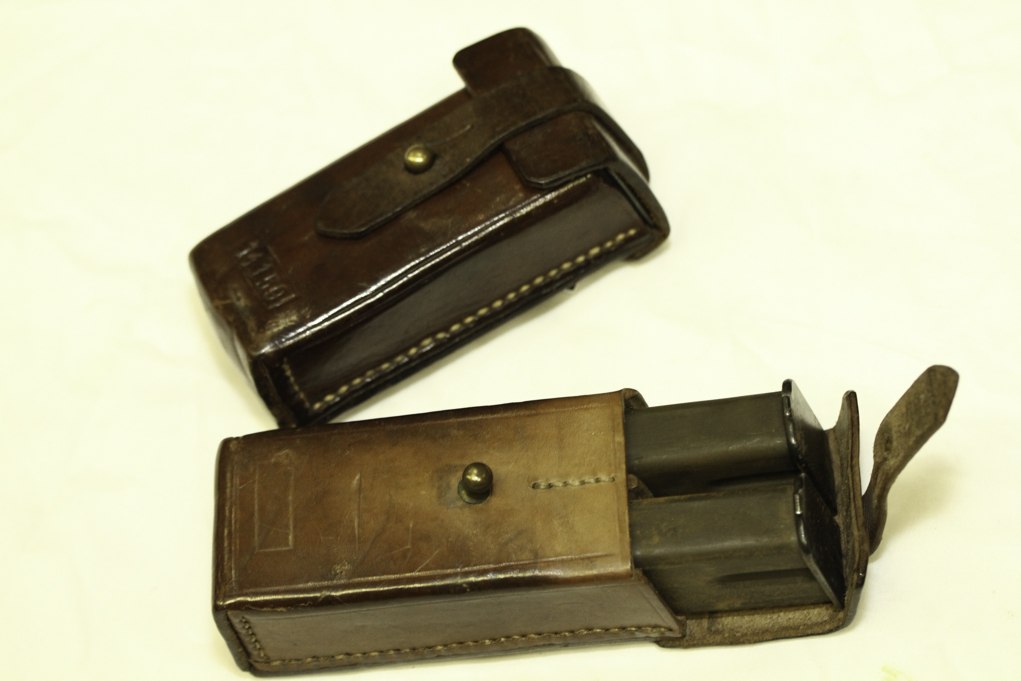
Hi Powers in WWII
During the war, we bombed and rained artillery down on the FN plant in Liege to deny its output to the Germans, and when they had to leave, they returned the favor. The place was a wreck by late 1944. The Belgians cleaned up the mess, rebuilt the plant, and began planning. You see, the war had changed many things, including the tools to be used in the next war. Nearly everyone took the lessons learned and began improving what they had. But not us. We pretty much stuck with what we had. Hey, we won the war, and what we used had won, so there wasn’t much pressure to change or upgrade.
A lot of countries felt differently. The rifle got the most focus. Once the U.S. Army had forced our allies to adopt a “new” rifle cartridge — the .308 Winchester — new rifles were needed for it. The .308, aka the 7.62 NATO, is essentially a .30-06 with a shorter case and ball powder, which takes up less volume for the same energy. The difference between them is essentially naught.
In the U.S., the rifle change was to adopt the M14, which is pretty much an M1 Garand with a 20-round box magazine. Even the Italians rebuilt their Garands into the M14 configuration, calling them the BM-59.
The rest of Europe went a different route. Saive, still at the helm at FN, took the 10-shot box magazine-fed FN-49 rifle and changed the externals, which produced the FN-FAL — a 20-round box magazine-fed battle rifle of amazing durability, adaptability, and reliability. It was also almost four feet long, but in the 1950s that wasn’t seen as that much of a problem.
How, you ask, does the worldwide adoption of the FAL figure into the history of the P-35, the Browning Hi Power? Simple: the same FN salesmen who were making sure the FAL earned the name “The Free World’s Right Arm” were also busy pushing the P-35. And why not? If you are going to re-arm your military with top-of-the-line battle rifles complete with service, repair, upgrades, and warranty, why not do the same with the sidearm?
It didn’t hurt that it used the ubiquitous 9mm Parabellum cartridge, and that it was used with great enthusiasm by all sides in World War II, and that it was made in the world-famous FN plant in Liege.
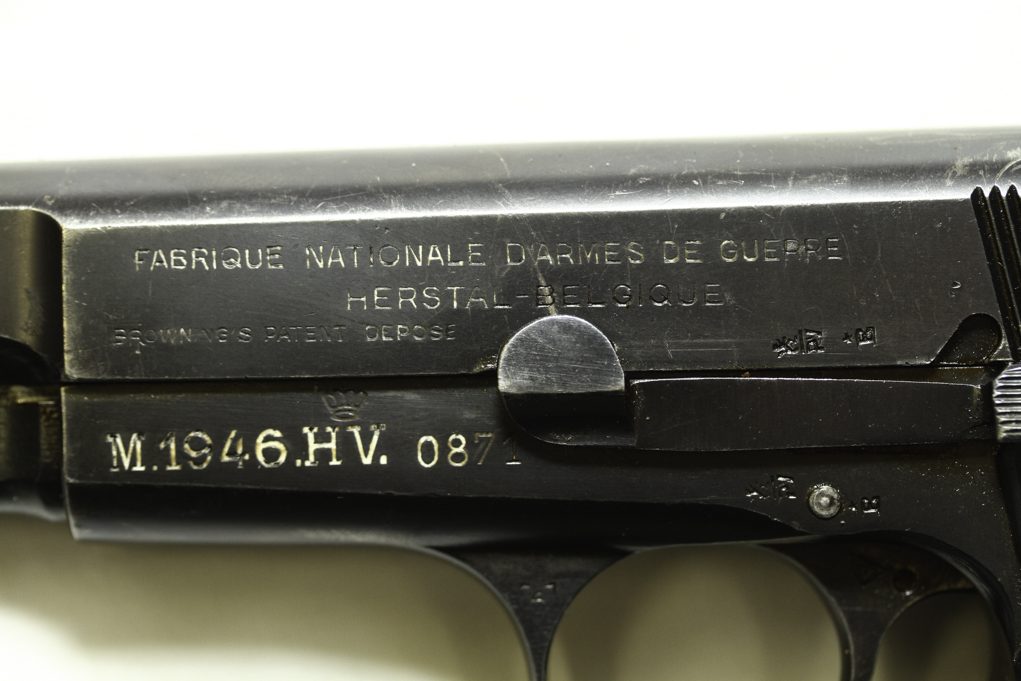
A Hi Power for the World
That’s how the Hi Power ended up in service in pretty much every noncommunist (and even some communist) countries. The Commonwealth countries were going to use the Hi Power once it was officially adopted by Great Britain. That meant Canada, New Zealand, Australia, and all the colonies.
Even after they shrugged off the status of a colony, a lot of the new countries kept using the Hi Power. Once in service, it was treated to various modifications, improvements, markings, and tests. The sights were changed and finishes applied. Generally, since there were a million of them out there, the users (or rather, the using organizations) felt free to try their hand at improving it any way they thought possible.
There were other countries that were more interested in having the production of essential arms in-country, and they licensed the manufacture from FN.
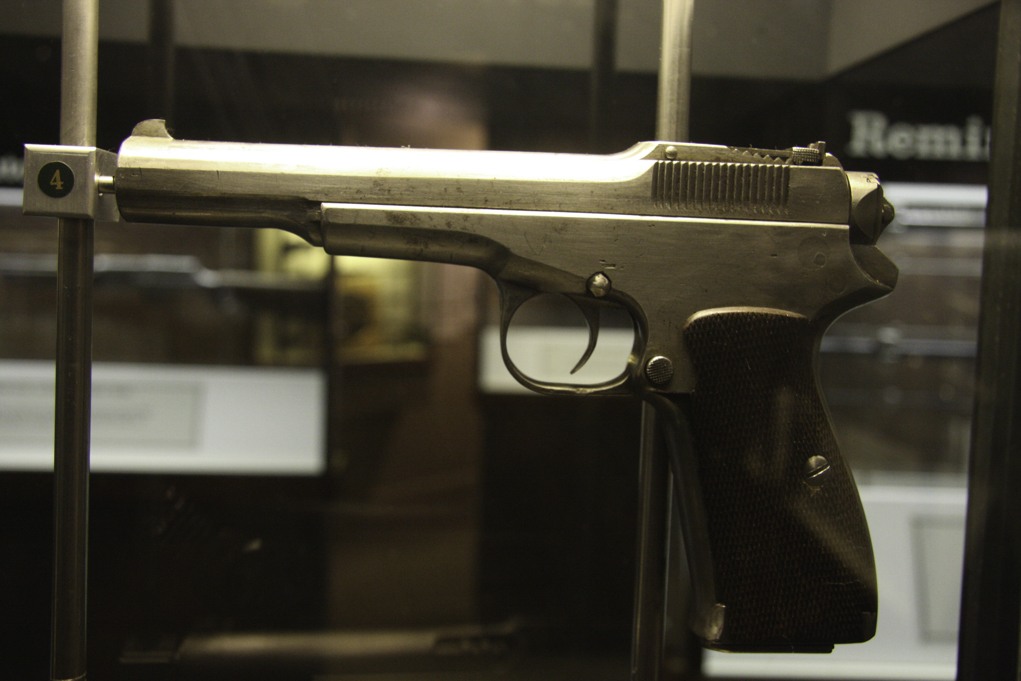
Argentina, for one, and Canada kept on using the ones built by Inglis and added more as they needed them. India, after becoming independent, began using the arsenals built by the British to manufacture firearms for their own use. The Indian government licensed the manufacture of the Browning Hi Power from the Inglis company and began making them in Ishapore. One of the other places those pistols went was Nepal.
In my travels around the world, I keep an eye out for the local police and military (in some places one and the same) to see what they are using. In Nepal I saw a truly historic range of firearms.
One museum had two Gurkha guards. One was armed with the utterly wretched Indian-made AK clone-compromise, the INSAS. It takes real work to make an AK-derived firearm that is unreliable, but trusted sources say the INSAS comes as close as any. The other Gurkha guard was armed with an Enfield three-band model 1853 rifled musket, complete with bayonet. I asked if I could take a photo and was given a smiling “No.”

Later that day, at the entrance to the local army base, I saw a sergeant armed with a holstered Hi Power. It had to have been either a British pistol dating from WWII or an Indian-made Inglis-licensed copy, but it was a Hi Power.
Later that day, at the entrance to the local army base, I saw a sergeant armed with a holstered Hi Power. It had to have been either a British pistol dating from WWII or an Indian-made Inglis-licensed copy, but it was a Hi Power.
Which brings us to the question.
Why Did the Hi Power Remain in Service for So Long?
The size and shape, to start. The pistol held a useful amount of ammunition, 12 or 13 rounds of 9mm in the magazine. The grip, depending on the panels installed, ranges from comfortable to alluring.
Its size is not burdensome to pack. It isn’t a bundle, as even the smallest carbines of the day would have been. As lightweight and handy as the US M1 Carbine is, it is still a carbine with a stock. Yes, that’s better than a handgun when you need to shoot, but until then a lot less handy, and a lot more of a hindrance than a holstered handgun.

Pistols smaller than the Browning Hi Power often don’t hold sufficient ammo or, if they do, it’s of an undersized cartridge. A sidearm larger than the Hi Power starts to verge into M1 Carbine territory, more hassle. The recoil was not a big deal, as some shooters back then (and yet today) felt the .45 ACP presents.
In many militaries and police departments worldwide, a handgun is a badge of office. In many places, the police are armed with the same rifle that the military uses because law enforcement is just the army dressed in blue instead of green.
The guy in charge of the local group has a holstered handgun because it is his job to supervise the rifle-armed guys, not enforce the laws himself. The holster marks him as the head guy in charge. For that purpose, pretty much anything that fits the holster and fires a bullet will do the job.
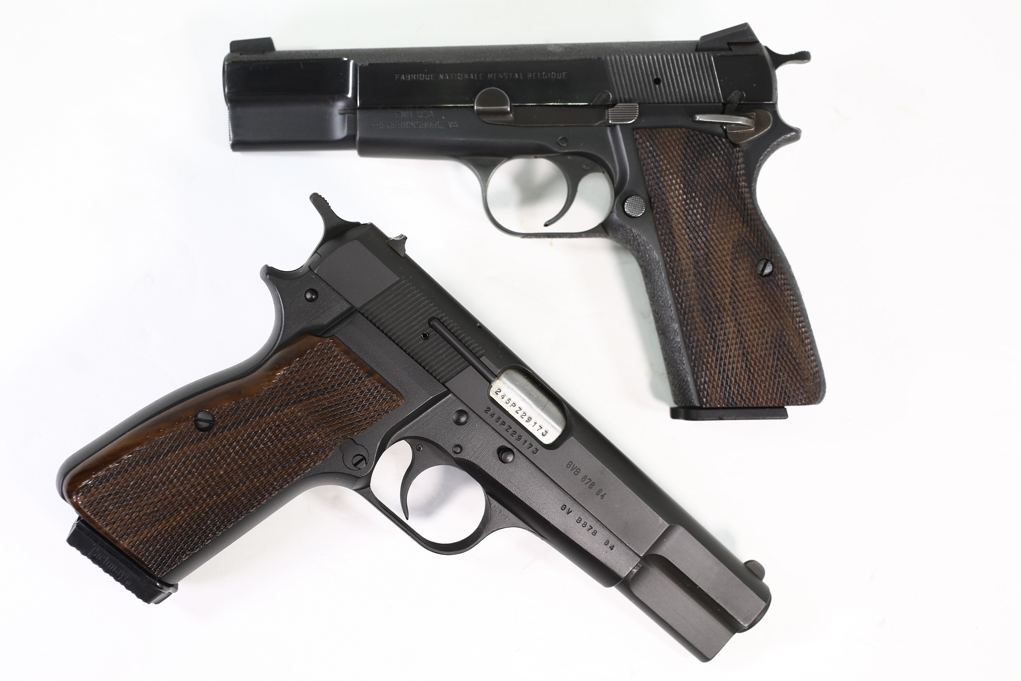
Hi Power, High Rank
The panache of the Hi Power extended beyond issue handguns. It was apparently not uncommon to see someone in the Vietnam War, someone who just couldn’t quite be placed as to what organization they were with, armed with the Hi Power. (That was true for non-GI rifles and submachine guns as well.)
Then again, if your senior NCO didn’t object, what was carried as personal gear in Vietnam seemed to be pretty much whatever you wanted. Some organizations were a lot more freeform than others.
The Browning Hi Power was more than just a badge of rank.
The frame was made from forged steel, with the magazine well, slide rails, and other openings machined from the forging. The barrel used the John Browning tilt-down method.
The slide and frame were locked together for a short distance until a cammed face on the bottom lug of the barrel struck the cross-lug in the frame. This caused the barrel to cam down out of the path of the slide, as the slide continued rearward.
Once to the rear of its travel, the slide moved forward, propelled by the recoil spring underneath the barrel. The slide forced a round out of the magazine, collected the barrel, then cammed the barrel up to lock it. Once closed, it was ready to fire again.
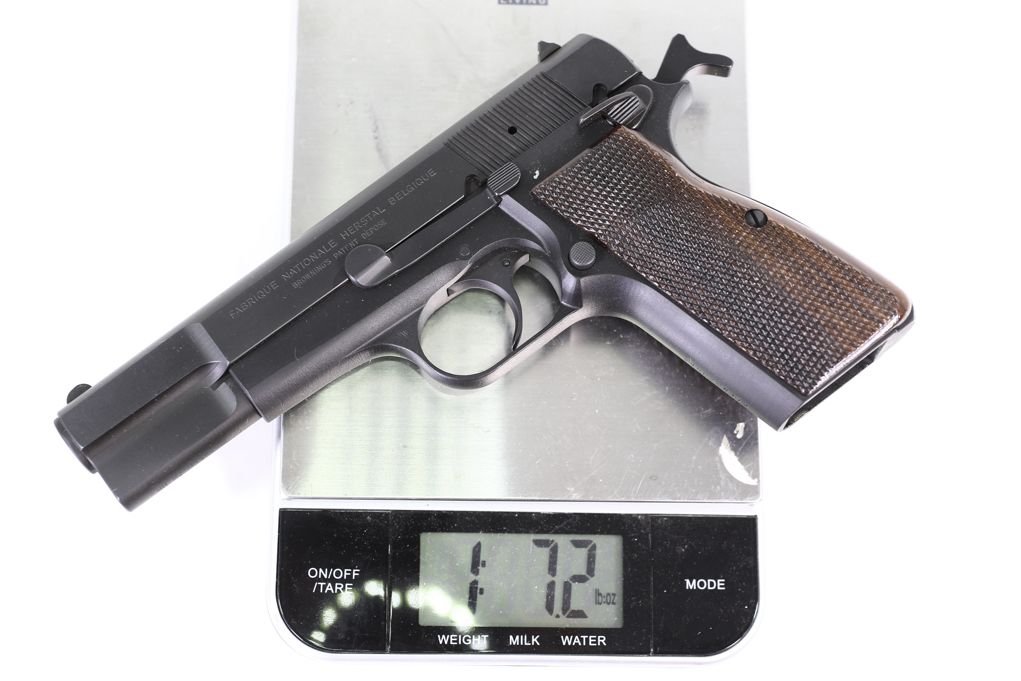
The locked-breech design allowed the Hi Power (and all other locked-breech pistols) to readily handle the recoil forces of the cartridge.
Without some means of locking the slide and barrel together at the start of the cycle, the upper limit of force the pistol cartridge can generate is limited — limited by the weight of the slide and the force of its spring, and the ability or willingness of the shooter to fire it.
For handguns chambered in anything larger than the .380 Auto cartridge, weight and required recoil spring forces become too great to make a handy pistol, or to find willing shooters.
The efficiency of the cam surfaces makes the Hi Power function with a relatively light slide and recoil spring. That means less weight to carry and less force needed to initially work the slide.
High Power Downsides
However, the design is not without its costs or drawbacks. One is the lack of a barrel bushing on the front of the slide. This makes barrel and slide manufacturing easier, as it eliminates several machining steps. But, the barrel can only be removed from the slide through the rear — unlike the 1911’s barrel that can be removed out the front or rear once the bushing is unlocked from the frame.
This became a stumbling block for pistolsmiths wishing to improve performance decades later. Fitting a replacement bushing in a 1911 allows for a more precise barrel fit and can improve accuracy. You can’t do that with the Hi Power.
When compensators or muzzle brakes became popular in IPSC competition, the Hi Power was left behind. On the P-35, once the brake or comp was attached the barrel could not be removed from the slide. This made cleaning a bit more difficult. On the 1911 it was easy to remove even with a comp or brake installed.
Another obstacle to pistolsmithing was the barrel lockup — specifically, the frame and what FN calls the “barrel seat.” The 1911 cams up and down on the slide stop pin, a removable, replaceable, and easy-to-fit part. The timing can be adjusted by using different-sized barrel links.
The Hi Power employs a cam that is pressed and staked into the frame. It cannot be serviced by anyone but the factory. The cam surfaces on the barrel are machined to a given dimension. Again, they are not serviceable by a pistolsmith, unless he or she obtains a barrel that has those surfaces over-sized and files and machines them to fit the frame and slide.
The Browning's Trigger Pull and Other Issues
The trigger pull is a problem. When it’s good, it’s fine. When it isn’t, it’s hard to work on. The 1911 (the exemplar here) has a few parts that operate in a simple manner, and many, many replacements to be had. The Browning Hi Power? The trigger pivots or cams against a lever, which likewise pivots, pressing down on the edge of the sear. Working on the Hi Power trigger requires the patience of Job and specialized skills.
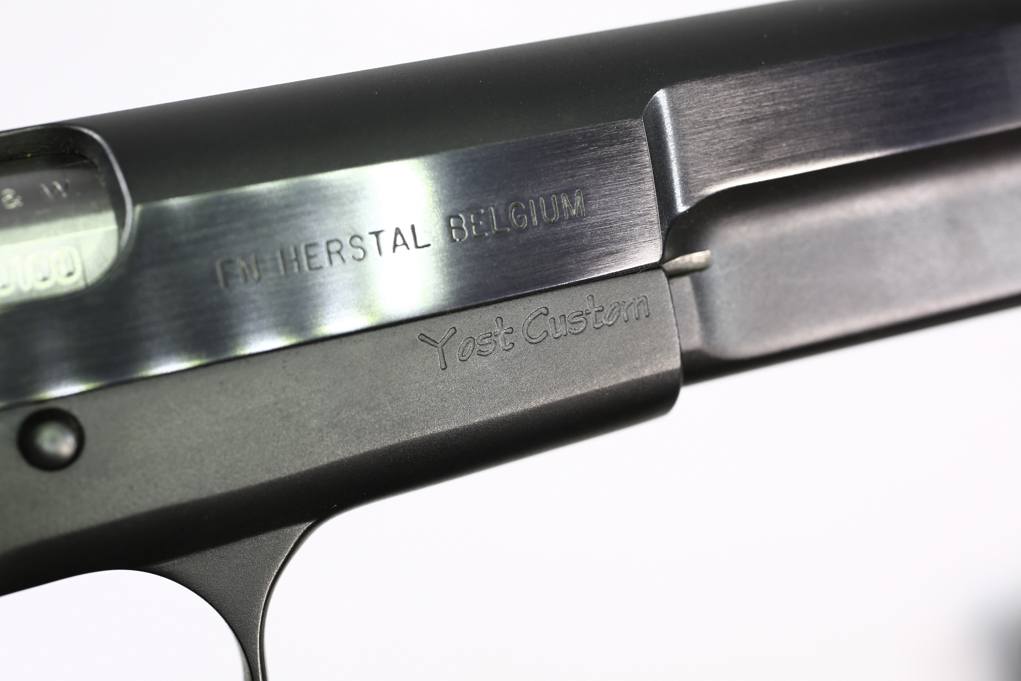
The thumb safety is worse. It is small, unusable as-is, and difficult to replace. You see, the thumb safety shaft is the hammer pivot shaft. Replacing a safety can adversely affect your trigger pull.
In a military setting those were not obstacles, they weren’t even noticed. If a slide, frame, or barrel became unserviceable, it was simply exchanged for a replacement part. That the new part fit somewhat loosely was not a problem, the old one was often no better.
Military organizations were interested in “minute of opponent” accuracy at just-outside-of-the-foxhole distances. And the standard carry method of a handgun in military service was with the hammer down, safety off, and chamber empty. Thumb safety shortcomings were not even noticed.
But, those were big deals to competition shooters and especially American users, who were interested in better ergonomics. Unlike most of the world, where the sidearm is a backup and often even just the badge of rank mentioned above, we Americans view the handgun as a fighting tool.
Yes, you use it to fight your way back to the rifle or shotgun you should not have put down, but you fight with it. It isn’t just a status symbol, and in many instances it is the only tool used.
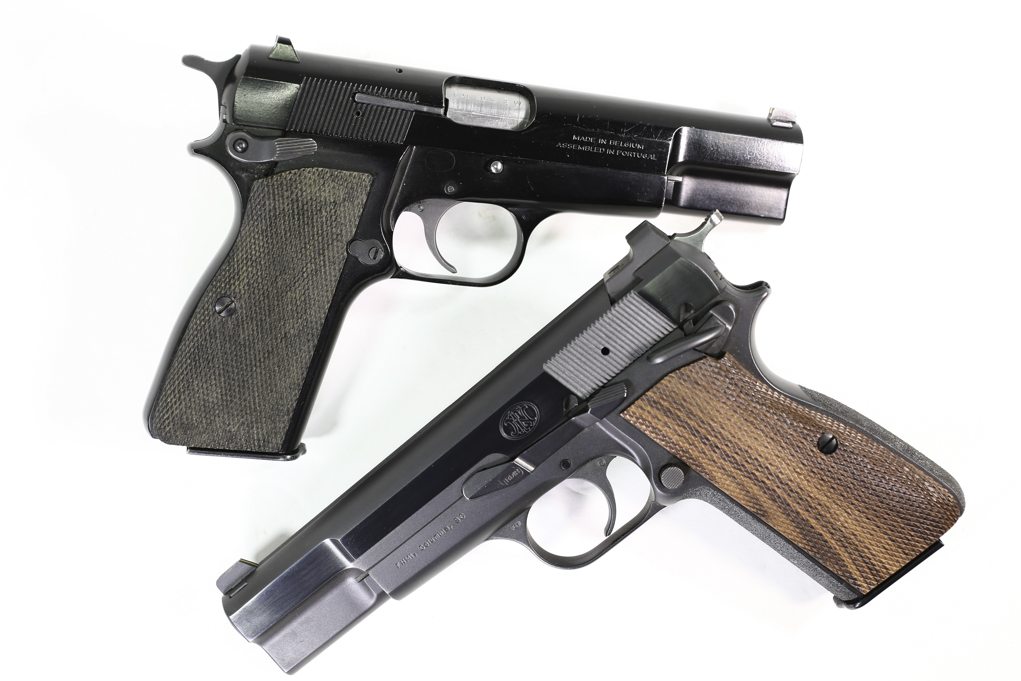
The Browning Hi Power in Competition & Police Use
In the early days of the now common but then radical competition known as IPSC, the Hi Power acquitted itself well. Today, IPSC is seen as a 9mm or .38 Super competition. Back then, it was a .45 competition. And yet, of the first four IPSC World championships, two were won with 9mm pistols, and one of those was a Hi Power.
Back in that era, the Hi Power was involved in one well-known conflict where both sides were armed not just with the same pistols, but the same rifles and machine guns as well.
We won’t go into the ownership of Las Malvinas, or The Falklands, but I do point out that the British and the Argentines used Hi Powers, FALs, and MAG-58 GPMGs all made by or under license from FN in Liege, Belgium.
I’ve been to the islands a few times and it is interesting to note that pretty much every bar or restaurant, museum, or public office has a captured, welded-inoperative FAL on display, but there are no Hi Powers similarly shown.
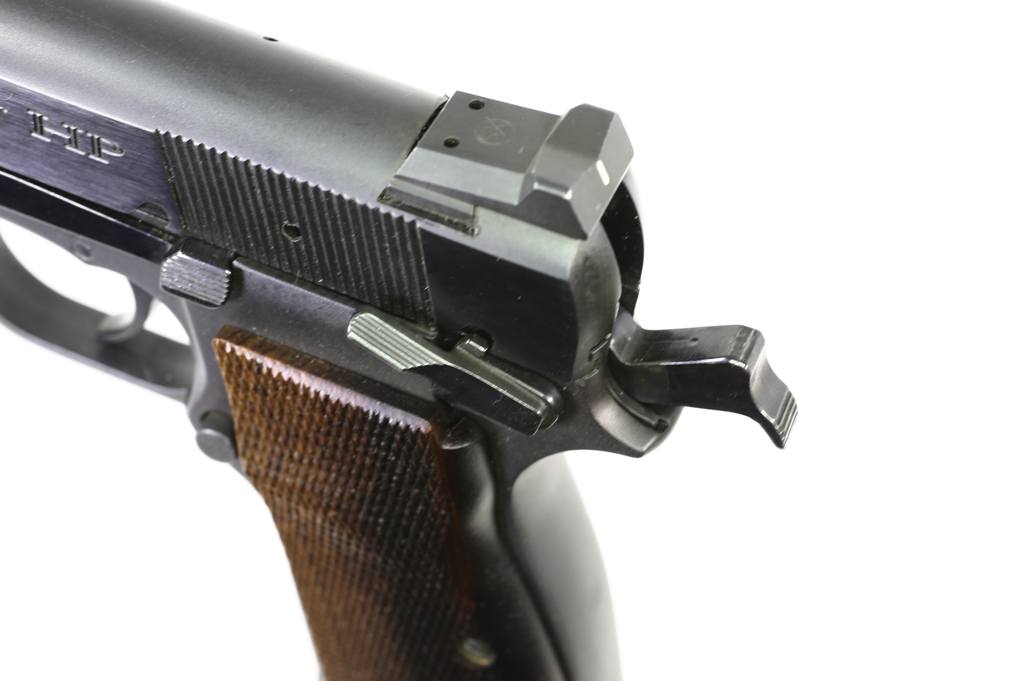
Hi Powers and the FBI
Here in the U.S., one agency that showed a lot of interest in the Hi Power was the FBI, specifically for its Hostage Rescue Team. Although, that was back when the FBI allowed personal weapons for service and the Hi Power was on the approved list.
They went to a great deal of effort in the mid-to-late-1980s to have Wayne Novak build up a batch of Hi Powers for them.
The initial build was to install Novak sights on the pistols, but after various shipments, returns for repairs and overhaul, and requests for improvements, they were a buffet of 9mms with a host of custom features. The plain guns went to the field agents, and (no surprise) apparently the ones with the custom features went to supervisors, office heads, and the like.
What the FBI found out was what we IPSC shooters had learned some years before: the original Hi Power was not a heavy-duty pistol. The FBI did not feed its Hi Powers anything but a steady diet of standard-pressure 9mm ammunition, unlike the U.S. Army and its first problems with the M9 pistol.
The M9 had issues in part because the idea of 9mm ammunition was new to the army. To the FBI, not at all. And despite using only standard pressure (not +P) ammunition, the FBI found, as the rest of us had, that the Hi Power couldn’t take the volume of shooting IPSC required.
In the days of Bullseye competition, you’d be hard pressed to shoot more than 5,000 rounds a year. A match ran you 50 rounds of ammunition. If you shot a match every single weekend and practiced once in between, that came to 5,200 rounds a year. That was considered a lot of shooting.
When I began IPSC competition I was shooting 10,000 rounds a year, and I was not keeping up with the Joneses. When I went to a Dillon loading press, I jumped up to 35,000 rounds a year and kept at it (or more) for the next 20 years.
A 1911, even when firing .45 ACP +P, or 9mm +P or +P+ ammo, can do that for as long as the barrel’s rifling holds up. Once you’ve worn out the bore, you can refit the slide to the frame, install a new barrel, and start over again.
I have several 1911s that have had 100,000 rounds or more through them, and you’d be hard-pressed to tell them from the lower mileage pistols. I am a slacker, as I know of people who have much more than that through their 1911s. The Hi Power? Tens of thousands in the old Mk II or earlier guns meant the end of service.
A Look at the Market
Browning was the importer of Hi Powers made by FN. When Browning wasn’t bringing in as many as the market wanted, other importers shipped in pistols made in places other than Liege. Sometimes, especially once the patents expired, the manufacturer would see if an American importer wanted to buy a batch of “just like Liege” licensed Hi Powers.
I have one like that, which was imported under the Charles Daly name, back when. These were Hungarian-made clones, and while I haven’t tried to see if small internal parts fit (none have shown signs they need to be replaced) magazines and grips fit just fine.
Interesting tidbit of info: they were imported as parts, assembled and fitted here in the U.S. — hence the “Made in USA” markings they bear.
Don’t get me wrong, the Hi Power will still be dependable even when heavily used. Our gun club’s treasurer a couple of decades ago, who used to work for the city of Detroit, carried a brace of T-Series Hi Powers.
This was during the bad old days when Detroit was aflame, and no one who needed a CPL back then could get one. He carried anyway. He used his so much that the recoil springs were more than a bit tired. I had a spring tester and the standard Hi Power recoil spring measured at 17 pounds.
His two 9mms had springs worn down to 10 and 11 pounds. They still worked.
But when parts start breaking or falling off, it’s time to move on. And move on we all did. So did the FBI HRT. One agency I still wonder about is the Hong Kong Airport Police.
I encountered them while traveling to the 1999 IPSC World Shoot in the Philippines. We changed planes in Hong Kong and the police made us get off the plane and identify our bags, and inspected our firearms transport paperwork.
They were bored, we were fascinated. We closely studied (all of us were gun geeks, there were 30-40 IPSC competitors for the match on that plane) the MP5s they carried, their handguns, holsters, etc. One thing we got tired of studying was their sloppy gun handling.
When one supervisor had trouble reading the paperwork in the fading light (we were out of the plane, on the tarmac, with the other passengers peering out through the plane’s windows at us), one of his subordinates lifted his MP5 over the boss’s shoulder and clicked on the light on its handguard.
Me, I looked around to see what I could hide behind should the inevitable accidental discharge happen. It didn’t, thank goodness.
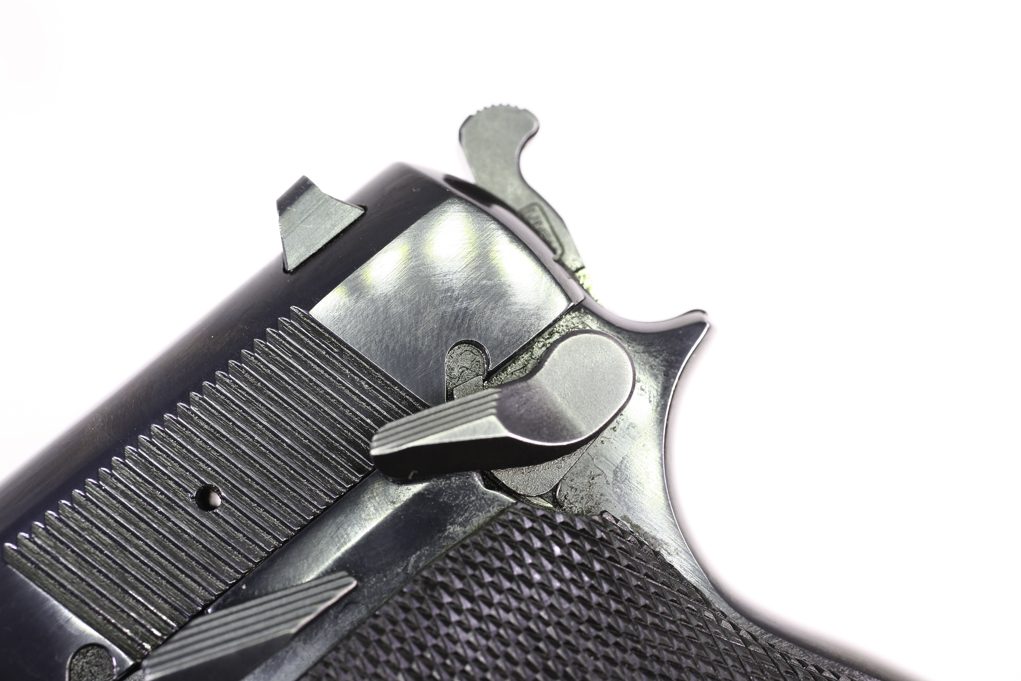
FN Struggles with the High Power
FN tried to keep up. One such change was the SFS. The Safe-Fast-Shooting system was an attempt to gain the benefits of a double-action (DA) pistol while retaining the upside of a single-action. The main benefit of the SFS was that the hammer was down. This made it appear to be a DA pistol and not one with a cocked hammer.
Once you loaded the SFS, you pushed the hammer down with your thumb. When it clicked into place, the thumb safety popped up to engage the system. You now had a hammer-down pistol with a thumb safety. On the draw, you could thumb the safety down, which caused the hammer to automatically pop up, ready to go to work.
.40-Caliber Hi Powers
The one big change that made a difference was the introduction of the .40 S&W cartridge. When Jeff Cooper and others were experimenting with a cartridge that was called the .40 G&A, they used a Browning Hi Power as their base pistol. They were happy with the results, but when the actual .40 came out in 1990 (their experiments had happened in the 1970s), things were different.
The prevailing wisdom of the time was that a .40 S&W pistol could be had simply by plugging a .40-caliber barrel into a 9mm model and installing a stiffer recoil spring. When the various pistol manufacturers did that, they found that the job was a lot tougher than they thought. It took a few years and a few model variants for everyone to work out the details.
FN built some .40 prototypes on their Mk II frames and tested them. Those R&D guns died in an embarrassingly short time span. The word on the street was that they lasted about 2,500 rounds, and then were simply scrapped.
The problem? The frames. A forged frame, one in which 85-90 percent of the steel is machined away, simply cannot be all that tough. So, FN went to cast frames for the Mk III.
Since the machining needed is just for cleanup or to reach the final dimensions, they could make the frames of much, much tougher steel. I have one of these, and Wayne Novak built it into his top-end clone of the HRT gun.
Testing the High Power
During testing for an article of the time, I put 23,000 rounds through it. I had two malfunctions in all that time. One was a low-powered lead bullet reload that had somehow gotten all the way to the chamber (but only partially into it) with a great big glob of bullet lube stuck to the case. The other was a seriously tired old 20-round magazine.
The spring, when I extracted it, was a full inch shorter than the spring in a brand-new 20-round magazine. So, both malfunctions were blamed on things other than the pistol.
For those willing to indulge a Major League Baseball analogy, these were chalked up to errors on the part of the fielders, and so not hurting the Hi Power’s ERA.
I have two other Mk IIIs, one a box-stock .40 that was a rental gun at Double Action range in Madison Heights, Michigan. They lost count of the ammo that had gone through it, but other than the usual handling and shop wear from going through a thousand hands, it looks, feels, and works fine. The other is a custom .40 built by Ted Yost. I managed to acquire it for less than the cost of the custom work Ted had done, so it’s a keeper for sure. It is also a tack driver.
The rarest one I have is a lightweight Hi Power. These were made a few times, and only in short runs with aluminum frames, which pared a few ounces off the weight.
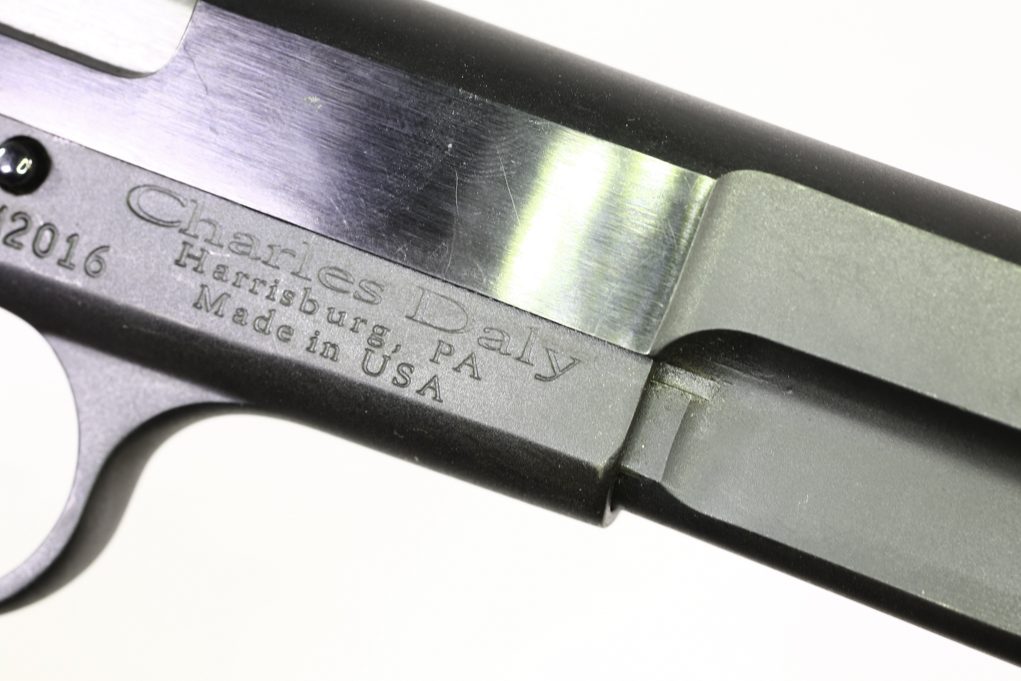
Custom & Collectible Hi-Powers
Just before Hi Power production ended, Nighthawk Custom imported a batch of FN Mk IIIs and built them into custom guns. The result was a hi-cap 9mm with more style than most people could handle but at the price of a custom 1911.
They also solved the hammer bite problem by welding on a tang to protect your hand. It was a love-it-or-hate-it proposition. If you must have the ne plus ultra of 9mm pistols, then track down a Nighthawk Hi Power. There will be no one who is not envious of you.
The Hi Power has a lot going for it — mystery, panache, style, grip-fit, and great looks to boot. So why has FN stopped making it? And why should you acquire one anyway? The word is that the tooling is worn out.
Me, I don’t buy it.
Modern CNC machining uses slabs of steel called tombstones to hold the parts. The “tooling” consists of the cutters that are shaped to make the exact cut needed for a part or dimension. Cutting tools are purchased by the gross by big-time manufacturers.
No, the truth is much simpler: the polymer-framed, striker-fired pistols have won. The soul-less, industrial, common-as-dirt with no heart pistol has taken over.
No one wants to pay what it would take to make a competitive Hi Power when you can literally buy a ready-to-go polymer handgun for half that amount.
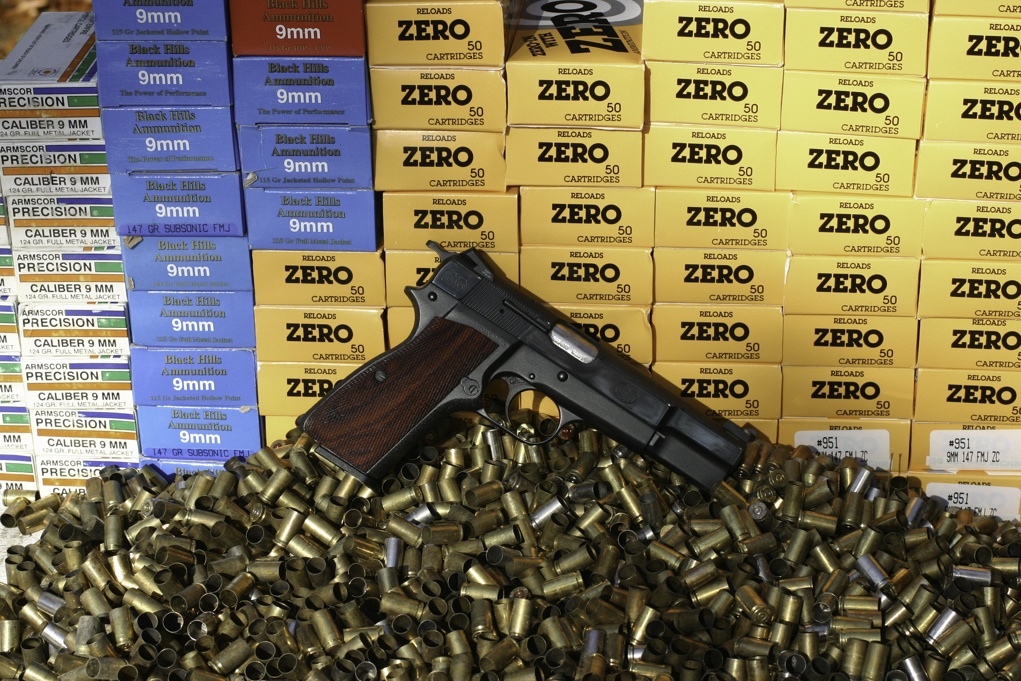
Oh, FN could make a ready-to-go Hi Power, one with a nice trigger, no bite, durability, and a thumb safety you could use. It would cost as much as two Glock G17s or more, and it would still, at best, hold 15 rounds to the G17’s 17+1.
Luckily, there are still makers of Browning's Hi Power, but those that are not Liege-made will be rougher, and you may have to do some persuading to find a pistolsmith to tame them. My advice? Get a Liege-made one now, while you still can. The Browning Hi Power, there’s nothing like it.
This article is an excerpt from Gun Digest 2019, 73rd Edition.
Corey Graff contributed to this article.

Next Step: Get your FREE Printable Target Pack
Enhance your shooting precision with our 62 MOA Targets, perfect for rifles and handguns. Crafted in collaboration with Storm Tactical for accuracy and versatility.
Subscribe to the Gun Digest email newsletter and get your downloadable target pack sent straight to your inbox. Stay updated with the latest firearms info in the industry.

![Best Concealed Carry Guns In 2025 [Field Tested] Wilson Combat EDC X9S 1](https://gundigest.com/wp-content/uploads/Wilson-Combat-EDC-X9S-1-324x160.jpg)


![Best 9mm Carbine: Affordable PCCs [Tested] Ruger Carbine Shooting](https://gundigest.com/wp-content/uploads/Ruger-Carbine-Shooting-100x70.jpg)
![Best AR-15: Top Options Available Today [Field Tested] Harrington and Richardson PSA XM177E2 feature](https://gundigest.com/wp-content/uploads/Harrington-and-Richardson-PSA-XM177E2-feature-100x70.jpg)

So much misinformation (other than about the mechanical workings of the pistol) in one article! How do you do that!
“For a while, Canada used decals to mark property.”
Patrick! Tell the collectors of Canadian military firearms and equipment how many of those various military items had the decal on them as the Inglis Hi-Power, as you claim Canada was wont to do with it’s military equipment of the day?
Imagine Canada putting that decal on all kinds of stuff – that decal that has Chinese calligraphy wrapping around the outside of the decal due to the initial P35s made by Inglis intended for the Chinese military, not Canadians and Brits.
That “unuseable safety”? Defeated because you can’t operate it with the pad of your thumb as though it were the paddle that is a 1911 safety? Well, the Tier 1 operators of multiple countries who issued those units the High Power never felt the need to change the safety or have their in-house gun plumbers do that. Just like they left the magazine disconnect just where it was when they received the pistols. Things that make you go “Hmmmm….”
“The Hi Power? Tens of thousands in the old Mk II or earlier guns meant the end of service.”
Really, so those Inglis pistols in Canada that were in use for 75 years, particularly the ones in their infantry battle schools that had recruits flowing through them and receiving basic weapons training, year after year… how many rounds of that military pistol/submachine gun ammo do you think went through those High Powers?
Wow… such an imagination Patrick! You could be a fiction writer posing as a gun writer!